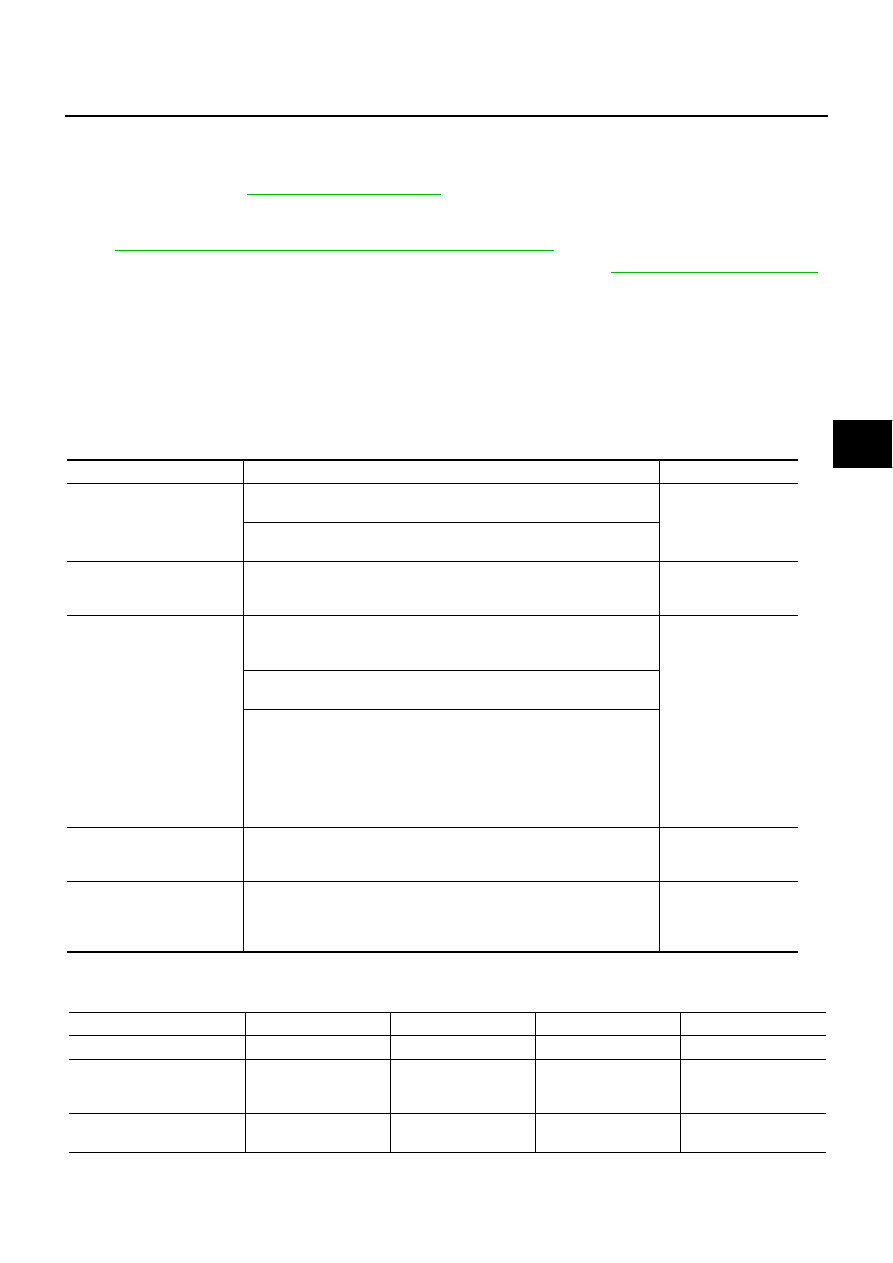Infiniti M45 (Y34). Manual - part 273

TROUBLE DIAGNOSIS
BRC-35
[VDC/TCS/ABS]
C
D
E
G
H
I
J
K
L
M
A
B
BRC
Correct and Quick Diagnosis
AFS001K3
DIAGNOSIS PRECAUTIONS
●
Before performing the trouble diagnosis, always read the general information (GI) to confirm the general
precautions. Refer to
●
When steering angle sensor, steering system components, suspension system components and when
adjusting the alignment, be sure to adjust the steering angle sensor neutral position before driving. Refer
to
BRC-6, "Adjustment of Steering Angle Sensor Neutral Position"
●
After completing service, always erase the self-diagnosis results. Refer to
●
When inspection of the continuity or voltage between units is performed, check connector terminals for
disconnection, looseness, bend, or collapse. If any non-standard condition is detected, repair or replace
applicable part.
●
Intermittent errors may be caused by a poor connection in the harness, connector, or terminal. Move har-
nesses, harness connectors, or terminals by hand to make sure all connections are solid and undamaged.
●
If a circuit tester is used for the check, be careful not to forcibly extend any connector terminal.
●
VDC/TCS/ABS is a system that uses electronic control to perform brake control and engine power control.
Therefore, phenomena like those shown in the following table may occur, but this is because the system is
working normally.
ON and OFF Timing for ABS Warning Lamp, VDC OFF Lamp, SLIP Lamp, Brake Warning
Lamp
×
: ON
–: OFF
Symptom
Symptom description
Result
Motor operation noise
The is a motor operation sound inside VDC actuator, and sometimes
there is a slight sound when VDC, TCS, or ABS operates.
Normal
Just after the engine starts, the motor operating noise may be heard.
This is a normal status of the system operation check.
System operation check
noise
When the engine is started, you may barely be able to hear a slight
thudding sound from the engine room, but this sound is made by the
system operation check and is normal.
Normal
TCS operation
(SLIP lamp ON)
TCS may be activated any time the vehicle suddenly accelerates, sud-
denly downshifts, or is driven on a road with a varying surface friction
coefficient.
Normal
Cancel the VDC/TCS
function for the
inspection on a chas-
sis dynamometer.
When inspecting the speedometer, etc., press VDC OFF switch to turn
off TCS function before conducting the work.
When accelerator pedal is depressed on a chassis dynamometer (front
wheel fixing type), the vehicle speed will not increase. This is normal,
because TCS is activated by the stationary front wheels. The warning
lamp may also turn on to show “sensor system error” in this case. This is
not a malfunction either, because the stationary front wheels are
detected. Restart engine, and drive the vehicle at 30 km/h (19 MPH) or
more to check that the warning lamp no longer turns on.
ABS operation (longer stop-
ping distance)
Stopping distance may be longer for vehicles with ABS when the vehicle
drives on rough or snow-covered roads. Use lower speeds when driving
on these kinds of roads.
Normal
Sluggish feel
Depending on road circumstances, the driver may have a sluggish feel.
This is normal, because under TCS operation optimum traction has the
highest priority (safety first). Sometimes the driver has a slight sluggish
feel in response to substantial accelerator pedal operation.
Normal
Condition
ABS warning lamp
VDC OFF lamp
SLIP lamp
Remarks
Ignition SW OFF.
–
–
–
—
Approx. Within 1 seconds
after ignition SW is turned
ON.
×
×
×
—
Approx. 1 seconds after igni-
tion switch ON.
—
—
—
Turns OFF 2 seconds
after engine starts.